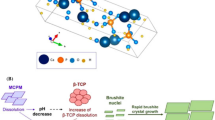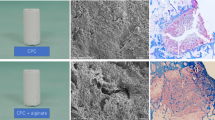Abstract
Brushite cements are known for excellent osteoconductive and degradation properties, however, its widespread use is limited due to rapid setting time and poor mechanical properties. The eggshell derived calcium phosphates exhibits improved physical and biological properties due to the presence of biologically relevant ions. In this study, eggshell derived brushite cement (EB) was fabricated using β-tricalcium phosphate synthesized from eggshells. The presence of trace elements in EB prolonged its setting time. The size of brushite crystals in EB was found to be smaller than the pure brushite cement (PB) leading to increased initial compressive strength and higher in vitro degradation rate. The L6 and MG63 cell lines exhibited good biocompatibility with the cement at the end 72 h. In vivo studies of the cements were performed in rat calvarial defect model. Micro CT analysis showed faster degradation and accelerated bone formation in EB filled defect. Histological studies revealed infiltration of inflammatory cells into the implant site for both the cements till 6th week. However, inflammation was found to be significantly reduced at the 12th week in EB compared to PB leading to complete bone bridge formation. Multi-ion substituted EB seems to be a potential bone substitute material with a reasonable setting time for ease of handling, higher mechanical strength, minimal inflammatory response and higher bone regeneration.











Similar content being viewed by others
References
Tamimi F, Sheikh Z, Barralet J. Dicalcium phosphate cements: brushite and monetite. Acta Biomater 2012;8:474–87.
Cama G, Barberis F, Capurro M, Di Silvio L, Deb S. Tailoring brushite for in situ setting bone cements. Mater Chem Phys. 2011;130:1139–45.
Constantz BR, Barr BM, Ison IC, Fulmer MT, Baker J, McKinney L, et al. Histological, chemical, and crystallographic analysis of four calcium phosphate cements in different rabbit osseous sites. J Biomed Mater Res. 1998;43:451–61.
Theiss F, Apelt D, Brand BA, Kutter A, Zlinszky K, Bohner M, et al. Biocompatibility and resorption of a brushite calcium phosphate cement. Biomaterials. 2005;26:4383–94.
Frayssinet P, Gineste L, Conte P, Fages J, Rouquet N. Short-term implantation effects of a DCPD-based calcium phosphate cement. Biomaterials. 1998;19:971–7.
Kuemmerle JM, Oberle A, Oechslin C, Bohner M, Frei C, Boecken I, et al. Assessment of the suitability of a new brushite calcium phosphate cement for cranioplasty – an experimental study in sheep. J Craniomaxillofac Surg. 2005;33:37–44.
Shariff KA, Tsuru K, Ishikawa K. Fabrication of interconnected pore forming α-tricalcium phosphate foam granules cement. J Biomater Appl. 2016;30:838–45.
Penel G, Leroy N, Van Landuyt P, Flautre B, Hardouin P, Lemaitre J, et al. Raman microspectrometry studies of brushite cement: in vivo evolution in a sheep model. Bone. 1999;25:81S–4S.
Apelt D, Theiss F, El-Warrak AO, Zlinszky K, Bettschart-Wolfisberger R, Bohner M, et al. In vivo behavior of three different injectable hydraulic calcium phosphate cements. Biomaterials. 2004;25:1439–51.
Lu JX, About I, Stephan G, Van Landuyt P, Dejou J, Fiocchi M, et al. Histological and biomechanical studies of two bone colonizable cements in rabbits. Bone. 1999;25:41S–5S.
Flautre B, Lemaitre J, Maynou C, Van Landuyt P, Hardouin P. Influence of polymeric additives on the biological properties of brushite cements: an experimental study in rabbit. J Biomed Mater Res A. 2003;66A:214–23.
Marinno FT, Torres J, Tresguerres I, Jerez LB, Cabarcos EL. Vertical bone augmentation with granulated brushite cement set in glycolic acid. J Biomed Mater Res A. 2007;81A:93–102.
Tamimi F, Torres J, Gbureck U, Lopez-Cabarcos E, Bassett DC, Alkhraisat MH, et al. Craniofacial vertical bone augmentation: a comparison between 3D printed monolithic monetite blocks and autologous onlay grafts in the rabbit. Biomaterials. 2009;30:6318–26.
Tamimi F, Torres J, Lopez-Cabarcos E, Bassett DC, Habibovic P, Luceron E, et al. Minimally invasive maxillofacial vertical bone augmentation using brushite based cements. Biomaterials. 2009;30:208–16.
Taha A, Akram M, Jawad Z, Alshemary AZ, Hussain R. Strontium doped injectable bone cement for potential drug delivery applications. Mater Sci Eng C. 2017;80:93–101.
Saleh AT, Ling LS, Hussain R. Injectable magnesium-doped brushite cement for controlled drug release application. J Mater Sci 2016;51:7427–39.
Bose S, Fielding G, Tarafder S, Bandyopadhyay A. Understanding of dopant-induced osteogenesis and angiogenesis in calcium phosphate ceramics. Trends Biotechnol 2013;31:594–605.
Kim SH, Kim W, Cho JH, Oh NS, Lee MH, Lee SJ. Comparison of bone formation in rabbits using hydroxyapatite and β- tricalcium phosphate scaffolds fabricated from egg shells. Adv Mat Res. 2008;47–50:999–1002.
Siva Rama Krishna D, Siddharthan A, Seshadri SK, Sampath Kumar TS. A novel route for synthesis of nanocrystalline hydroxyapatite from eggshell waste. J Mater Sci Mater Med. 2007;18:1735–43.
Gbureck U, Grolms O, Barralet JE, Grover LM, Thull R. Mechanical activation and cement formation of β-tricalcium phosphate. Biomaterials. 2003;24:4123–31.
Jayasree R, Sampath Kumar TS, Pavani Siva Kavya K, Rakesh Nankar PP, Mukesh D. Self setting bone cement formulations based on egg shell derived tetracalcium phosphate bioceramics. Bioceram Dev Appl. 2015;5:084.
ASTM C191-13. Standard test methods for time of setting of hydraulic cement by Vicat Needle. West Conshohocken, PA: ASTM International; 2013.
ASTM F451-16. Standard Specification for Acrylic Bone Cement. West Conshohocken, PA: ASTM International; 2016.
Gashti MP, Bourquin M, Stir M, Hulliger L. Glutamic acid inducing kidney stone biomimicry by a brushite/gelatin composite. J Mater Chem B. 2013;1:1501–8.
Chen X, Huang W, Zhou J. Effect of moisture content on compressive and split tensile strength of concrete. Indian J Eng Mater Sci. 2012;19:427–35.
Qiu QQ, Mendenhall HV, Garlick DS, Connor J. Evaluation of bone regeneration at critical-sized calvarial defect by DBM/AM composite. J Biomed Mater Res Part B Appl Biomater. 2007;81B:516–23.
Kannan S, Vieira SI, Olhero SM, Torres PMC, Pina S, da Cruz e Silva OAB, et al. Synthesis, mechanical and biological characterization of ionic doped carbonated hydroxyapatite/b-tricalcium phosphate mixtures. Acta Biomater. 2011;7:1835–43.
Siddharthan A, Sampath Kumar TS, Seshadri SK. Synthesis and characterization of nanocrystalline apatites from eggshells at different Ca/P ratios. Biomed Mater. 2009;4:045010.
Marino FT, Torres J, Hamdan M, Rodriguez CR, Cabarcos EL. Advantages of using glycolic acid as a retardant in a brushite forming cement. J Biomed Mater Res B Appl Biomater. 2007;83B:571–9.
Barralet JE, Tremayne M, Lilley KJ, Gbureck U. Modification of calcium phosphate cement with alpha-hydroxy acids and their salts. Chem Mater. 2005;17:1313–9.
Lilley KJ, Gbureck U, Wright AJ, Farrar D, Barralet JE. Investigation into carboxylic acids as cement reactants. Bioceramics. 2006;18:853–6.
Huan Z, Chang J. Novel bioactive composite bone cements based on the beta-tricalcium phosphate-monocalcium phosphate monohydrate composite cement system. Acta Biomater. 2009;5:1253–64.
Alkhraisat MH, Tamimi F, Rodriguez CR, Jerez LB, Lopez-Cabarcos E. Combined effect of strontium and pyrophosphate on the properties of brushite cements. Acta Biomater. 2008;4:664–70.
Thorwarth M, Rupprecht S, Falk S, Felszeghy E, Wiltfang J, Schlegel KA. Expression of bone matrix proteins during de novo bone formation using a bovine collagen and platelet-rich plasma (prp)—an immunohistochemical analysis. Biomaterials. 2005;26:2575–84.
Acknowledgements
The authors would like to thank SAIF, IIT Madras for the ICP-AES measurements. We also thank Professor Krishnan Balasubramaniam, Center for Non-Destructive Evaluation, IIT Madras for extending the micro-CT facility for our study.
Author information
Authors and Affiliations
Corresponding author
Ethics declarations
Conflict of interest
The authors deny any actual or potential conflicts of interest related to the study.
Additional information
Publisher’s note Springer Nature remains neutral with regard to jurisdictional claims in published maps and institutional affiliations.
Rights and permissions
About this article
Cite this article
Jayasree, R., Kumar, T.S.S., Venkateswari, R. et al. Eggshell derived brushite bone cement with minimal inflammatory response and higher osteoconductive potential. J Mater Sci: Mater Med 30, 113 (2019). https://doi.org/10.1007/s10856-019-6315-x
Received:
Accepted:
Published:
DOI: https://doi.org/10.1007/s10856-019-6315-x




